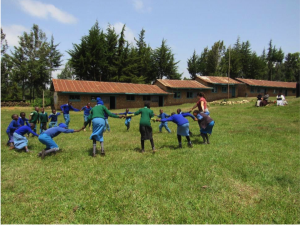Blog – Michaela Rowan
My name is Michaela Rowan and I am a nutrition student from the University of Prince Edward Island. I have been in Kenya for two weeks now working with the university partnered with Framers Helping Farmers in Naari, Meru County. I will be spending three months here for a summer internship under the QE II scholars. The work I am helping with involves the projects of two Masters students from Kenyatta University looking at food security and diet diversity in women from the Naari area.
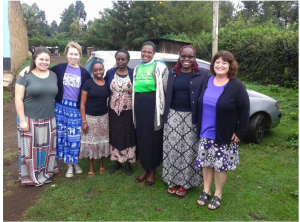
This past week, the nutrition team started collecting data and visiting the homes of women from the Upendo women’s group. During these home visits, we ask a series of questions that assess diet diversity, food security and if the work and training within the women’s groups is affecting these. Being invited and going into the homes of these women has been an eye-opening experience. In some of the houses there are not enough places for everyone to sit and in several situations we have sat on tables of even tires in the yard. When compared to most homes in Canada, I think about just how much we have in excess; from furniture to possessions and to access of food.
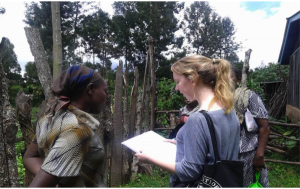
The women we have visited have also shown us so much hospitality and generosity. Many of the times when we finish the questionnaires, we are offered Kenyan tea (Chai) and food. We have been given bananas, avacodos, eggs, bread and more!
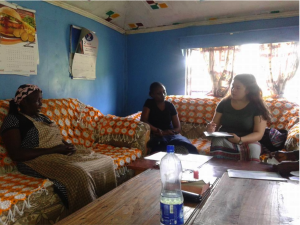
In Kenya, much of the outcome of the crops and harvest comes from having adequate water or rain to nourish the growing plants. If there if not enough rain, unfortunately the crops will not provide as much food. One if the projects Farmers Helping Farmers has done has been to install water tanks and drip irrigation into the kitchen gardens of these women. This way, when it rains heavily, water can be saved and then used specifically for the growing gardens. During one particular home visit, one of the women thanked me for all Farmers Helping Farmers had done. Although she could not speak directly to me in English, it was translated that the tanks and drip irrigation had helped improve her garden and the growth of her food by a significant amount. Hearing this woman thank me and other Canadians was very touching and inspiring. I can’t wait to continue working with the women’s groups of Naari and finding out what else is in store during my stay in Kenya!
Blog – Mireyne MacMillan
Hi- this is Mireyne MacMillan again from the nutrition team in Naari, Kenya. It is mind boggling to think that it has almost been one month since arriving to Kenya! My experiences so far have been nothing but positive as our nutrition team continues to work with the incredible Naari community. Last week, we completed our first assessment of the school meal at Muruguma Primary School, which is very close to the house that we live in. This school recently received a water tank and drip irrigation from Farmers Helping Farmers to support a garden to grow healthy vegetables for the children! We assessed their preparation of uji, which is similar to a porridge/cream of wheat, and githeri, which is a corn and bean based dish, to determine if there are any recommendations we can make to improve these dishes. In between our assessments of the breakfast and lunch meals, we had the opportunity to visit classes ranging from nursery class to standard 8 (grade 8).
When we first entered the classes, the students were timid and unsure of what to think of the ‘Mzungu’ (white/traveller) visitors. We broke the ice by attempting to use the little Kimeru we have learned for our introductions. The students then showed us some of the English activities they had been working on, which was incredibly impressive. We also gave the students the chance to ask us anything about Canada. The topics ranged from Canadian agriculture, seasons, to our federal voting system.
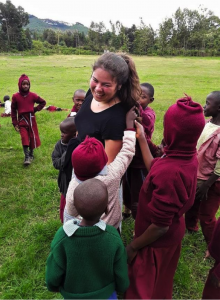
Although the students were shy upon our first meeting, they quickly warmed up to us when we were able to join them outside on their break. We were soon surrounded by these curious students who wanted to get to know us better. The students taught us how to play traditional Kenyan games, showed off some dance moves and sang us some favourite songs as well. We were told our laughter and singing was clearly heard by distant neighbours. The afternoon spent with these energetic, joyful and bright young individuals was one of the best times I’ve ever had, which made it so difficult to leave. It was great to have the UPEI veterinary students Ren Chamberlain and Julia Kenny along for our school visit so they can see what the nutrition team does.
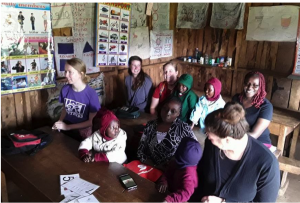
Last week we also held our peer led teaching session with the Upendo women’s group. The purpose was to teach nutrition messages and cook traditional dishes to show the how they can be made to increase their nutritional value and still taste delicious! We reviewed some messages from 2016, including using mpempe (whole grain) maize and soaking it to improve digestibility and nutrition) and adding dark green vegetables near the end of cooking time (“on the top”). This year, we added new messages: use equal amounts of maize and beans in the githeri to increase protein; add one orange and one green vegetable to githeri to increase β-carotene (or pre-vitamin A). With these teachings, we are aiming for a ‘healthy pot’: a githeri that has less starch, more protein and lots of vitamins. Also new this year was a message about the importance of deworming their children to ensure children can fully benefit from their meals.
The teaching was led by six members, who are called ‘champs’. These women were selected in 2016 because they demonstrated genuine interest in learning about the nutrition messages and teaching them to the 25 other members. We started the day early (8:30) in order to ensure the dishes would be prepared on time. We selected three dishes: super-uji, super-githeri and super-mukimo. These dishes were labeled ‘super’ because the recipe modifications would benefit the women and their families. The added ingredients were selected based on what the women were most likely to grow in their kitchen gardens and to be consistent with our nutrition messages. The women agreed to use whole grain mpempe maize in the githeri (and whole grain maize flour in the uji), add lots of carrots, orange fleshed sweet potatoes and leafy green pumpkin leaves, kale and even thaa, or stinging nettle. Since thaa can cause a painful rash, the women carefully washed it with wooden spoons and then transferred it with the spoons to the pot of mukimo for cooking. It was fascinating to see how they have learned to use this prickly plant which grows wild but is very nutritious. The talented women went on to lead the cooking process, and we tried our best to keep up!
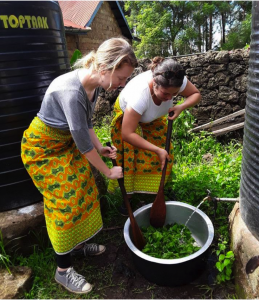
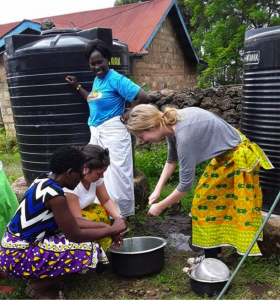
While the food cooked, the champs began the teaching sessions. They did such an amazing job teaching these messages in the Kimeru language and answering any questions the ladies had. There were great discussions created after the teaching session for further clarification. Afterwards, we were able to try the super meals! Based on the smiles on everyone’s face and the lack of leftovers, the dishes were a big hit!
And of course, the teaching session was not finished until we were all dancing and singing afterwards!
May 10, 2017 – Mireyne MacMillan
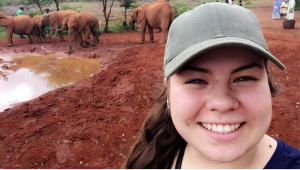
Hi there! My name is Mireyne MacMillan and I am from Mount Stewart, Prince Edward Island. I am a third-year Foods and Nutrition student at UPEI and am currently in Naari, Kenya completing a 3-month internship from the Queen Elizabeth Scholars program. If you wish, you can follow my journey here!
It’s incredible to think that it has been a full week since our plane from Prince Edward Island took off. It is the furthest I have ever travelled, and I was very excited! 26 hours and 8000 miles later, we safely made it to the International Jomo Kenyatta airport in Nairobi. However, our luggage was not so lucky and was lost somewhere within the air travel universe. This is when we quickly applied the Kenyan ‘sawa sawa’ way of living that we had heard of, and decided that it would work itself out and not to worry. The important part was that we had all made it safely. Our Kenyan contacts who met us the night of our arrival made us feel welcome and that we were in good hands. Stepping outside into the sweet, warm Kenyan air was like a dream: we had finally made it! After resting and having our first taste of an authentic Kenyan breakfast, we set out to see what Nairobi had to offer. We initially saw how incredibly lively and busy this Kenyan city is. The amount of traffic is incredible, yet there are so many people walking in each and every direction.
We started our day at the elephant orphanage, where we had the opportunity to see about 30 young elephants and listen to their stories. Many were rescued from wells, traps, or had lost their mothers to poachers, even though that it is illegal. I was extremely moved just from seeing how beautiful, playful and curious these young elephants are and how attached they are to their passionate care takers. It’s uplifting to visit a site like this, where their main objective is to rescue and care for these vulnerable elephants while educating the public on poaching. Next, we stopped in at the Kazuri Beads and Pottery Shop-Kazuri means small and beautiful in Kiswahili. They employ about 140 local Kenyans, most of which are women. The majority of the
employees are from or currently live in surrounding slums. The clay is taken directly from Mount Kenya where it is transported to this factory where it undergoes days of processing to turn into the beautiful beads and pottery. The final products are sold as jewellery and pottery within their local shop, but also shipped across the world, to destinations such as the Netherlands, Canada and the U.S. This is an admirable organization for many reasons including the large percentage of women employed, the respect the employees are treated with, and the benefits offered, which even includes daycare services. Other spots we were able to visit include the Giraffe manor and a beautiful fabric store located in the downtown area of Nairobi.
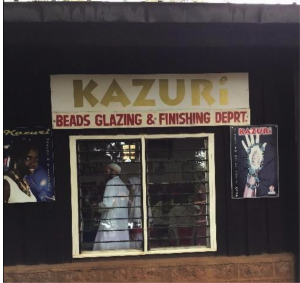
On Thursday, we began our 6 hour venture Northeast to Naari, in Meru district. Our first stop brought us to a roadside produce market, where we found incredibly beautiful and fresh fruit from local farmers. We had a great samosa lunch at Karatina, where we were called ‘Mizungus’ or travelers, for the first time. We also stopped in Nanyuki and got a chance to see where the equator line is! The drive did not seem long with the surrounding landscapes and the jetlag that many of us were still feeling. We arrived in Naari in the early evening, and our luggage shortly followed. I was taken aback by how beautiful the surrounding area is. There are beautiful hills, fields, trees, singing birds and entertaining sheep. The only thing that outdid the beautiful landscape that is Naari, was the kindness of the Kimeru people. We met three young children who live next door, as they were swift to come by and make us feel welcomed with extremely infectious and beautiful smiles.
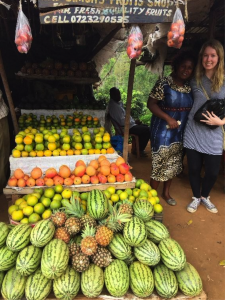
Friday, we woke up to ‘no steama’, or no power. Sawa sawa though, we had a full day ahead of us. We met with the Naari Dairy Cooperative, where we could physically see how much Farmers Helping Farmers has contributed to this community. The chairman expressed his appreciation for the organization, as without their help and resources there would be no Naari Dairy. It was eye opening to learn the amount of work that goes into collecting the milk, testing the milk’s quality and then transporting it. And it is amazing that they are starting a sacco- a bank that can help farmers get micro-credit that they need, particularly in the dry season.
Over the weekend, we continued to get settled and meet the great people of Naari and the surrounding areas. On Saturday, we had lunch with Salome, who has been working with Farmers Helping Farmers for many years. She’s an incredible partner and has been influential in facilitating essential communication between our nutrition team and the local women groups. Mary, a member of the Upendo women’s group, also joined us. She has been an invaluable in translating our home visits. During our meeting, we reviewed and translated the questionnaires for our home visits, to ensure they are relevant and correctly translated in Kimeru. During these home visits, we will be assessing the quality of the women’s food intake, household food security (food poverty) and the knowledge and attitudes and practices concerning family nutrition.
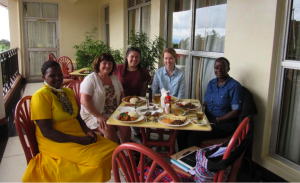
Today (Monday), we began our home visits with the Upendo women’s group. The women were very patient and willing to help us with our research. We were able to see first hand water tanks and drip irrigation systems provided through Farmers Helping Farmers that really help these rural women. It has been such a huge learning experience just within the first week and I am so grateful to be a part of it!
FHF Blog- School Assessment and Seminars
By: Michaela Rowan and Grace Wanjohi
Now that we’ve been in Naari, Kenya for over two months, we want to tell you about the nutrition team’s work with 9 schools in our area.
We visit every school twice within a two week period. During the first visit, the first stop is usually at the office of the head teacher or principal of the school. Here, we request permission to assess the school meals. We also explain how the meals will be assessed for their nutrient content. Finally, we agree on a date for a second visit to report on our assessment and conduct a parent’s seminar, which is a session of teaching nutrition messages to the parents.
The next stop is the cookhouse, or kitchen, where meals are prepared for the children. These meals include uji (maize porridge), which is often served to the nursery children only, and githeri (a stew made with maize, beans and sometimes vegetables) which is served for lunch to all students. After we see how the meals are being made, which ingredients are being used and what amounts are used, and measure the serving sizes the children are getting, our team will evaluate the nutritional content of the mal and compare it to nutrient requirements for the male and female students in the various age groups and write a report to give back to the school.
During our second visit to the school, we go over the feedback in the report with the head teacher and administration of the school. We discuss recommendations to improve their school meals, such as soaking the maize and beans, using whole grain maize and using a 1:1 ratio for the maize and beans in the githeri. We have not analyzed all the data yet, but we notice that the schools which have their own gardens and have been using drip irrigation really show a difference in the nutritional value of the lunches. With the gardens and drips, the schools are able to provide green and orange vegetables (like kale, carrots and orange sweet potatoes) more often, which provides nutrients like β-carotene (the plant form of vitamin A) and vitamin C that are otherwise missing from the children’s diets. Supplying a good source of these nutrients is very important since both are very important in growth and in helping children to resist infection.
We also take the opportunity to talk to the parents of the school children. This year, for the first time, we held nutrition education seminars for the parents after we meet with the head teacher and administration. We discuss several nutritional messages in a seminar while providing a food sample of “super” githeri with whole grain (mpempe) maize, extra beans for protein, one orange and one green vegetable and more vegetables overall. The food is very popular and shows them that preparing githeri the nutritious way tastes delicious.
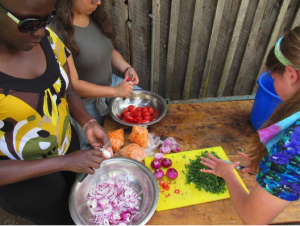
Sarah visited schools in the summer of 2016, so she was a great support as we learned how to do the school meal assessments.

This one has carrots- we are hoping to see more vitamin A rich orange fleshed sweet potatoes as an increased number of schools are growing them.
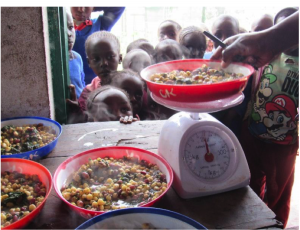
The nutrition education seminars with the parents have been a very positive experience. When discussing the nutritional messages with the parents, I can see their eagerness to learn on their faces. Usually, after each message, we get plenty of questions regarding what we are discussing and typical Kenyan cooking methods which can make for a good discussion. I always look forward to the school seminars. I think it is an effective way to talk to the parents/community about important nutrition messages since we can reach over 100 parents at one time! The attendance is amazing and it shows their interest in being educated about feeding their children. Also, since the parents provide most of the foods for the schools, it is great being able to meet and discuss directly with them the best methods and foods to provide for optimal nutrition for their children.
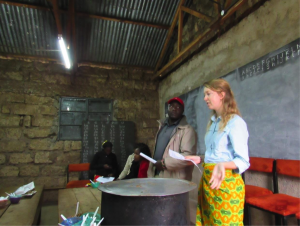

Unfortunately, some of the schools we have visited have been having difficulty providing maize and beans to the children. There have not been enough rains this season, so there have not been good
harvests. This also increases the price of maize and beans if they are available for purchase (this year there is a national maize shortage). Parents provide these foods to the school for their children, and in the case of some schools, they have run out of beans and are only serving maize to the children. Some will soon run out of maize. The schools that have gardens, water tanks and drip irrigation provided through Farmers Helping Farmers can provide green and orange vegetables which improve the school lunches nutritionally, but the maize and beans are still an issue when there aren’t enough rains. This is so important since beans are the main source of protein for the growing children and their families and this may be their only meal of the day. While Colleen Walton from Farmers Helping Farmers was here, she was able to alert local government officials about the food shortages; we hope that the schools in Naari will be able to get enough food to last until the next harvest.
It has been amazing to see the new school cookhouses from Farmers Helping Farmers sponsored by the Souris Village Feast. The schools which currently have traditional cookhouses are almost unbearable to remain inside while the food is cooking due to the amount of smoke. At one school, I (Michaela) tried to stay in for several minutes to help cook the githeri but my eyes were watering and it was difficult to breathe! The cook stayed inside the whole time without any complaints, but we know that the smoke is bad for their health, and the cookhouses require a lot of wood for fuel compared to the new cookhouses which have energy efficient stoves.
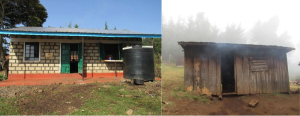
L: A typical school cookhouse. R: Michaka Primary School’s beautiful new cookhouse sponsored by the Souris Village Feast.


The warm reception of the kitchen staff and the fact that they work in these conditions day in, day out makes us appreciate and really commend these heroic women and men for their great service to the Kenyan students. This year, there are four newly twinned schools with FHF, and after seeing the work that has already been done, it is a great feeling knowing that more schools will benefit from working with Farmers Helping Farmers and the generosity of the Souris Village Feast. I understand the Village Feast is coming up soon (Sunday July 16) http://www.villagefeast.ca/. I know now just how important it is to support this event so that more schools will have cookhouses!
All in all, we’ve really enjoyed visiting the schools! The teachers and staff are welcoming each time and the children have amazing energy and are always excited to have visitors. During the days that we assess the school meals, there is usually some time during break to play with the children. This is one of my favorite parts since the children are full of excitement and have lots of ideas for games. One of the things we enjoy doing is to sing songs we are familiar with and learn some of their familiar Kenyan songs (and dances). Working with the schools in Naari has truly been a very rewarding experience.
